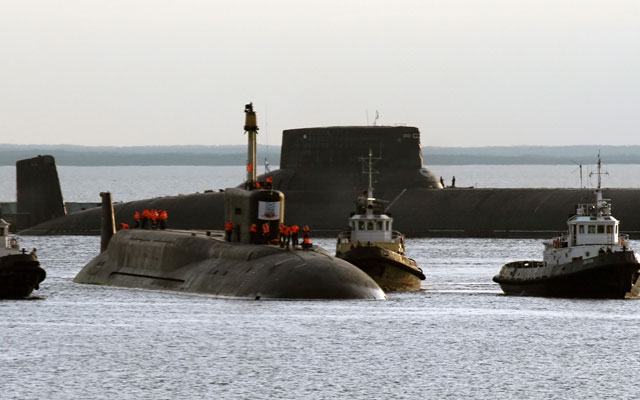Last week, after long delays, Russia made operational a new ballistic missile submarine (SSBN), or nuclear submarine, for the first time in over 20 years. This marks a significant step forward for the Russian Navy, which has pledged tens of billions of dollars to revitalize its fleet in the near future. The U.S. Navy unfortunately has had trouble both in revitalizing its SSBNs as well as its overall naval fleet.
The Russian navy made the announcement that the Yury Dolgoruky (Project 955)—the first-in-class of the new Borey-class SSBN—made operational status as it prepares for one of its largest naval exercises since the end of the Cold War. In fact, Russia’s commitment to increasing naval strength has been a central theme during Russian President Vladimir Putin’s tenure as president—despite Russia’s historically meager performance as a naval power. The Borey-class subs were first designed in the 1980s and the Yury Dolgoruky construction was launched in 1996.
Meanwhile, the U.S. navy has shrunk significantly since the Reagan years. The days of the 600-ship fleet have long since ended, and now U.S. naval leaders are struggling to find ways to meet a new requirement of around 300 ships. Currently around 285, the fleet will shrink further if more investment isn’t made in naval modernization.
The U.S. fleet was eroding long before the Budget Control Act and sequestration became part of the equation. In 2010, the Congressional Budget Office (CBO) reported that actual funding levels for 2005–2010 fell below the CBO’s and the Navy’s estimates to achieve fleet goals. Predictions show current funding levels would reduce the fleet to 263 ships. While the sequestration cuts to defense have been temporarily delayed as part of the fiscal cliff deal, they are still a looming possibility and would shrink the fleet to its lowest level since 1915.
While Russia has shown improvements in its strategic SSBN fleet (two more Borey-class subs are under construction), the U.S. has fallen behind its own standards. The legal minimum for the U.S. Navy’s SSBN fleet is 12 boats. Given this fleet’s status as the most survivable leg of the U.S. nuclear triad, the requirement should not be taken lightly. However, the Obama Administration delayed the development of an Ohio-class SSBN replacement for two years, which will in turn cause the fleet to fall below 12 boats for a 14-year period. As rogue states such as Iran and North Korea get closer to having nuclear weapons and increasing ballistic missile technology, the significance of this fleet is certainly not shrinking.
The President has downplayed the size of the fleet by making oversimplified arguments that each ship’s capability makes strength in numbers less significant. Yet with Russia aggressively growing its naval capability, resulting in a greater presence on the high seas, as well as China paying increased attention to naval capability, the U.S. must continue to uphold its status as the dominant global naval power. The fiscal year 2013 National Defense Authorization Act states that “the continuous at-sea deterrence provided by a robust and modern fleet of nuclear-powered ballistic missile submarines is critical to maintaining nuclear deterrence and assurance and therefore is a central pillar of the national security of the United States.”
Both Congress and the President need to keep this support up to maintain America’s robust naval fleet. As Secretary of the Navy Ray Mabus has argued, “[Q]uantity has a quality all its own.”



























